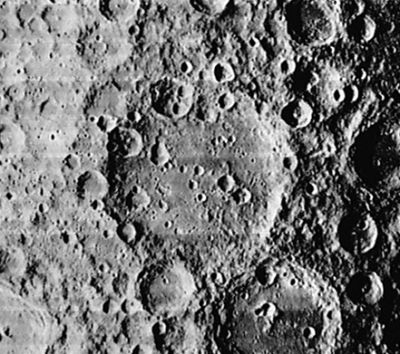Pasteur
Contents
Pasteur
|
Lat: 11.9°S, Long: 104.6°E, Diam: 224 km, Depth: km, Rükl: (farside), [/Stratigraphy pre-Nectarian] |
Table of Contents
[#Pasteur Pasteur]
[#Pasteur-Images Images]
[#Pasteur-Pasteur in Carl Sagan's COSMOS Pasteur in Carl Sagan's COSMOS]
[#Pasteur-Maps Maps]
[#Pasteur-Description Description]
[#Pasteur-Description: Wikipedia Description: Wikipedia]
[#Pasteur-Additional Information Additional Information]
[#Pasteur-Nomenclature Nomenclature]
[#Pasteur-LPOD Articles LPOD Articles]
[#Pasteur-Bibliography Bibliography]
[#Pasteur-Louis Pasteur in the Sourcebook Project (William R. Corliss) Louis Pasteur in the Sourcebook Project (William R. Corliss)]
 LO-II-196M Pasteur is at the center of this view which extends from 43-km [/Ganskiy Ganskiy] on the west (relatively small crater with central peak cut by center left margin) to 87-km [/Meitner Meitner] on the east (cut by center right margin). Below Pasteur (just outside the rim at about 7 o'clock) is 75-km [/Backlund Backlund], and to its east, the upper part of 151-km [/Hilbert Hilbert]. The large crater partially visible in the extreme lower left corner is 127-km [/Sklodowska Sklodowska]. The smaller IAU-named craters [/Khvol%27son Khvol'son], [/Ludwig Ludwig] and [/Debus Debus] are also visible in this medium resolution Lunar Orbiter II view.
LO-II-196M Pasteur is at the center of this view which extends from 43-km [/Ganskiy Ganskiy] on the west (relatively small crater with central peak cut by center left margin) to 87-km [/Meitner Meitner] on the east (cut by center right margin). Below Pasteur (just outside the rim at about 7 o'clock) is 75-km [/Backlund Backlund], and to its east, the upper part of 151-km [/Hilbert Hilbert]. The large crater partially visible in the extreme lower left corner is 127-km [/Sklodowska Sklodowska]. The smaller IAU-named craters [/Khvol%27son Khvol'son], [/Ludwig Ludwig] and [/Debus Debus] are also visible in this medium resolution Lunar Orbiter II view.Images
LPOD Photo Gallery Lunar Orbiter Images Apollo Images
Close ups of the pronounced crater Pasteur D (9° South/ 109° East, northeast of Pasteur itself):
AS12-56B-8308, AS12-56C-8308, and AS12-56D-8308
Research: Danny Caes
Pasteur in Carl Sagan's COSMOS
Something for those who still have Carl Sagan's legendary book COSMOS (1980). Please take a look at page 84 because the impressive orbital Apollo photograph on it (which shows the moon's curved horizon and crescent earth above it) also shows the northwestern part of Pasteur. This photograph was made during the mission of Apollo 12 in november 1969. The ID-number of this photograph is AS12-47-6890 (Hasselblad magazine 47-V).
Research Danny Caes
Maps
([/LAC%20zone LAC zone] 82C1) USGS Digital Atlas PDF LAC nomenclature map
Description
Description: Wikipedia
Additional Information
- Concentric Crater at 11°50' South/ 104°55' East (almost at the centre of Pasteur, near Pasteur M).
Nomenclature
- Named for Louis Pasteur (December 27, 1822 – September 28, 1895), a French chemist best known for his remarkable breakthroughs in microbiology. His experiments confirmed the germ theory of disease, also reducing mortality from puerperal fever (childbed), and he created the first vaccine for rabies. He is best known to the general public for showing how to stop milk and wine from going sour - this process came to be called pasteurization. He is regarded as one of the three main founders of bacteriology, together with Ferdinand Cohn and Robert Koch. He also made many discoveries in the field of chemistry, most notably the asymmetry of crystals.
- Name originally given by Lamech to a nearside crater, but never approved by the IAU ([/Whitaker Whitaker], p 228).
- What is most likely the present crater Pasteur was identified in Lunik 3 imaging and given its present name in the Russian Atlas of the Far Side of the Moon (1960). This name was approved in [/IAU%20Transactions%20XIB IAU Transactions XIB] (1961), although considerably revised coordinates were later published in [/Menzel%2C%201971 Menzel, 1971].
- Pasteur D (the 36-km crater with the central peak just outside Pasteur's rim at about 2 o'clock in the LO-II view) is mapped as [/Stratigraphy Copernican] by the [/USGS USGS].
- During planning for Apollo 8, the first manned circumlunar mission (1968), astronauts and mission planners (perhaps unaware that this crater already had a name, or uncertain of its identification), referred to Pasteur by the informal name of "Borman", a name that is now used for a completely [/Borman different] farside crater (see Phil Stooke's LPOD).
- Pasteur T is called Voltaire on LTO 82-D2. Who was Voltaire? See this Wikipedia-page.
LPOD Articles
Bibliography
Louis Pasteur in the Sourcebook Project (William R. Corliss)
- Page 329 in Mysterious Universe, a handbook of astronomical anomalies (1979) :
- Additional Notes on the Question of Living Bacteria in Stony Meteorites (Sharat K. Roy, Popular Astronomy, 1937).
This page has been edited 1 times. The last modification was made by - tychocrater tychocrater on Jun 13, 2009 3:24 pm - afx3u2